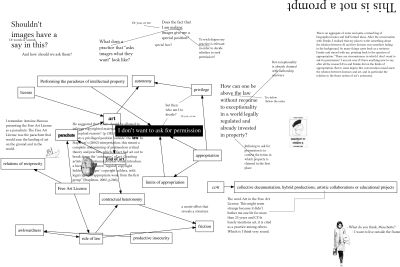P-Prompt: Quasi licence
When we invited Mexican writer and feminist new media and technology scholar Gabriela Méndez Cotato join the reading group "Limits to Openness" in 2023 we were very much interested in Gabriela's reuse of Mexican writer Cristina Rivera Garza's work on disappropriation. In the conversations that followed, Gabriela stressed that we don't need more licences but to articulate the power dynamics that escape any licence. She suggested working with quasi licences, that include a concept of good will or good faith, including the articulation of prescriptions that could be relevant in the moment of negotiating the meaning of the licence in particular settings.
“Have you worked with the idea of “buena fe”? It translates literally from Spanish to “good will” or “good faith”. It's a juridical term here [in Mexico] “to act in good will”, and it does have some weight. If you can prove that somebody did not act in good faith or goodwill then there are consequences. And that's where a sense of ethical responsibility comes in — in our relation to others. I don't know if that's playing a role in your project with licences, but it is something that could work within a non-normative or non-content based framework*. Because in my opinion, as a practitioner who has worked in this particular experiment with the radical open access community, I’d say, we don't need more licences. We need to understand, and maybe articulate in a more explicit way, as feminism has been doing for decades, the power dynamics that escape any licence.
It's the problem of the law in general, since the law is not the same as justice, and we have to keep interrogating the law from its margins, from its limits. The issue with licences is, when you think you have achieved a licence that will prevent violence or all violence, well, then you will have reached a point at which you render the law and justice equivalent. And for me, that's injustice, that's unethical. That's my concern with juridical thinking in general. It would be interesting to produce something like a quasi licence, that includes a concept of good will or good faith. Such quasi licence would include prescriptions that could be relevant at the moment of negotiating the meaning of the licence in particular settings.
Nicolas Malevé organised with Constant the event Copy.Cult discussing various aspects of the culture of the copy. It sparked the beginning of many defining, inspiring and influential interventions, activities, and reflections on authorship and ownership and Free Culture. Asking Nicolas, many years later, to revisit and rearticulate some of that history in the form of a prompt wasn't trivial. Eventually he wrote to us that
“This conversation raised anew the relation between licences and art, and in particular the relation to the thorn notion of art’s autonomy. This might seem strange because it didn’t bother me one bit for more than 25 years, but my relation with free licences back then begins with a very art-oriented debate. I think that the Free Art Licence (FAL) was quite efficient to keep art with a capital A at bay, to relativise it. CC4r, interestingly, barely mentions art, it is cited as a practice among others 'collective documentation, hybrid productions, artistic collaborations or educational projects', which is, I think, very sound." (Nicolas, private email)
Finally, Nicolas contributed with a tentative labyrinthine map that sets out to reflect the precarious and rather partial process of making sense of the residual dilemmas involved in arts' autonomy: "[You said], there are circumstances in which you don’t want to ask for permission. And I agree, I too, really don’t. But how can we start to be above the law without recourse to exceptionality in a world legally regulated and already invested in property? Perhaps my prompt would be along the lines of revisiting autonomy, which is a risky business." (Nicolas, private email)

